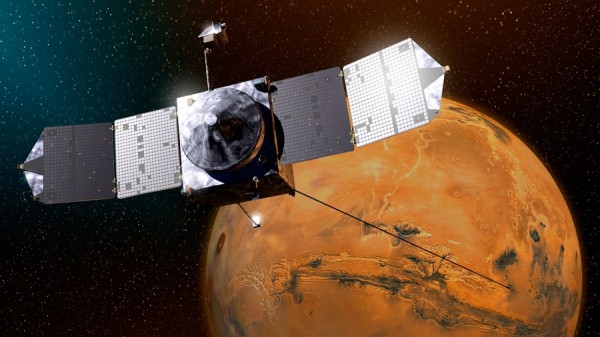By Ana Verayo, | April 12, 2017

An artist concept of the MAVEN spacecraft and the limb of Mars. (NASA's Goddard Space Flight Center)
NASA's Mars orbiter MAVEN has detected metal in the Red Planet's atmosphere. MAVEN has been observing the upper atmosphere of Mars to look for clues about how the dry and arid planet lost its atmosphere. During the orbiter's observations, it picked up evidence of metal ions that are linked to some previously unknown atmospheric activity in its ionosphere.
Like Us on Facebook
NASA mission scientists consider these metallic particles in Martian atmosphere as constantly travelling in high speeds due to being exposed to raining tiny meteoroids that instantly disintegrate as they enter Mars. These metal atoms also transform immediately into electrically charged atoms as some of their electrons are shed by other charged particles within the ionosphere.
According to the lead author of the study, Joseph Grebowsky of NASA's Goddard Space Flight Center, MAVEN confirmed that this is the first direct detection of the permanent presence of metal ions in the ionosphere of another planet other than Earth. Metallic ions possess longer lifetimes and can travel to different regions on Mars via electric fields and neutral winds. MAVEN (Mars Atmosphere and Volatile Evolution Mission) can track this movement within the ionosphere and reveal how these metal ions stream within Martian atmosphere.
Earth's atmosphere apparently also contains metal ions. NASA has revealed that there is indirect evidence suggesting that metal ions also exist on other planets within the solar system. However, this long-term direct detection of these metal ions by MAVEN is considered as the first conclusive evidence that ions also exist on other planets.
NASA MAVEN scientists also say that despite the existence of metal ions on Mars, these are still vastly different from metal ions found in Earth's atmosphere. On Earth, these metallic ions are separated into layers due to its magnetosphere and winds flowing within the ionosphere. On the other hand, Mars only possesses localized magnetic fields that have been fossilized in specific regions. Metal ion distributions on Mars are detected within layers that are unlike anything observed on Earth.
The detection of metal ions in the atmosphere of Mars can provide a better understanding of the formation and behavior of high altitude clouds and overall Martian atmosphere. This can also shed new light on how interplanetary dust can impact exoplanetary atmospheres.
This new study was published in the journal, Geophysical Research Letters.
-
Use of Coronavirus Pandemic Drones Raises Privacy Concerns: Drones Spread Fear, Local Officials Say

-
Coronavirus Hampers The Delivery Of Lockheed Martin F-35 Stealth Fighters For 2020

-
Instagram Speeds Up Plans to Add Account Memorialization Feature Due to COVID-19 Deaths

-
NASA: Perseverance Plans to Bring 'Mars Rock' to Earth in 2031

-
600 Dead And 3,000 In The Hospital as Iranians Believed Drinking High-Concentrations of Alcohol Can Cure The Coronavirus

-
600 Dead And 3,000 In The Hospital as Iranians Believed Drinking High-Concentrations of Alcohol Can Cure The Coronavirus

-
COVID-19: Doctors, Nurses Use Virtual Reality to Learn New Skills in Treating Coronavirus Patients







